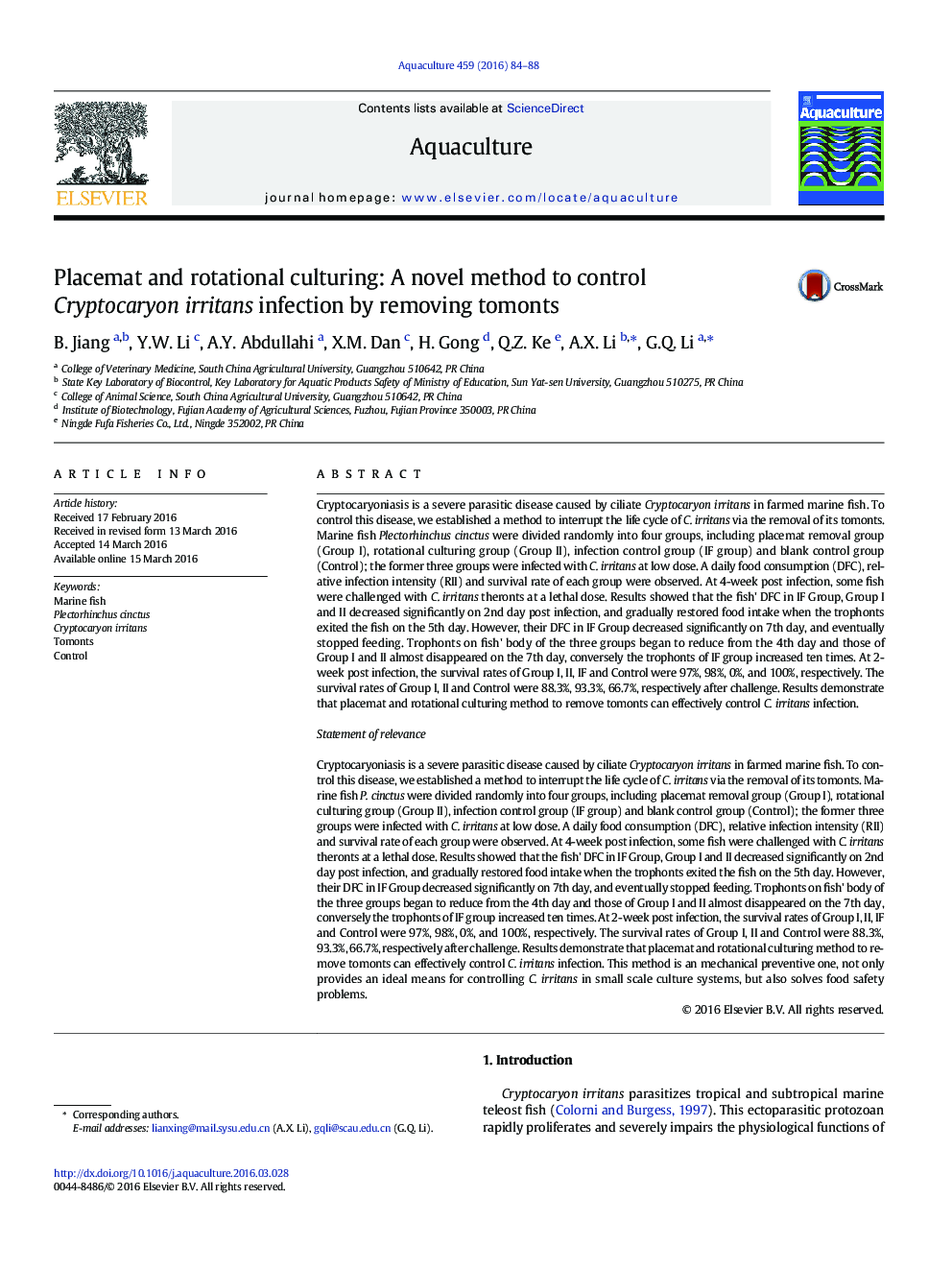| کد مقاله | کد نشریه | سال انتشار | مقاله انگلیسی | نسخه تمام متن |
|---|---|---|---|---|
| 2421409 | 1552828 | 2016 | 5 صفحه PDF | دانلود رایگان |
• A new method to control C. irritans infection by means of placemat and rotational culturing to remove tomonts was developed.
• The survival rates of placemat group, rotational culturing group, infection control and blank control were 97%, 98%, 0%, and 100%, respectively.
• The relative protection rate of placemat and rotational culturing group was 61.67% and 74.44% compared with blank control.
Cryptocaryoniasis is a severe parasitic disease caused by ciliate Cryptocaryon irritans in farmed marine fish. To control this disease, we established a method to interrupt the life cycle of C. irritans via the removal of its tomonts. Marine fish Plectorhinchus cinctus were divided randomly into four groups, including placemat removal group (Group I), rotational culturing group (Group II), infection control group (IF group) and blank control group (Control); the former three groups were infected with C. irritans at low dose. A daily food consumption (DFC), relative infection intensity (RII) and survival rate of each group were observed. At 4-week post infection, some fish were challenged with C. irritans theronts at a lethal dose. Results showed that the fish' DFC in IF Group, Group I and II decreased significantly on 2nd day post infection, and gradually restored food intake when the trophonts exited the fish on the 5th day. However, their DFC in IF Group decreased significantly on 7th day, and eventually stopped feeding. Trophonts on fish' body of the three groups began to reduce from the 4th day and those of Group I and II almost disappeared on the 7th day, conversely the trophonts of IF group increased ten times. At 2-week post infection, the survival rates of Group I, II, IF and Control were 97%, 98%, 0%, and 100%, respectively. The survival rates of Group I, II and Control were 88.3%, 93.3%, 66.7%, respectively after challenge. Results demonstrate that placemat and rotational culturing method to remove tomonts can effectively control C. irritans infection.Statement of relevanceCryptocaryoniasis is a severe parasitic disease caused by ciliate Cryptocaryon irritans in farmed marine fish. To control this disease, we established a method to interrupt the life cycle of C. irritans via the removal of its tomonts. Marine fish P. cinctus were divided randomly into four groups, including placemat removal group (Group I), rotational culturing group (Group II), infection control group (IF group) and blank control group (Control); the former three groups were infected with C. irritans at low dose. A daily food consumption (DFC), relative infection intensity (RII) and survival rate of each group were observed. At 4-week post infection, some fish were challenged with C. irritans theronts at a lethal dose. Results showed that the fish' DFC in IF Group, Group I and II decreased significantly on 2nd day post infection, and gradually restored food intake when the trophonts exited the fish on the 5th day. However, their DFC in IF Group decreased significantly on 7th day, and eventually stopped feeding. Trophonts on fish' body of the three groups began to reduce from the 4th day and those of Group I and II almost disappeared on the 7th day, conversely the trophonts of IF group increased ten times. At 2-week post infection, the survival rates of Group I, II, IF and Control were 97%, 98%, 0%, and 100%, respectively. The survival rates of Group I, II and Control were 88.3%, 93.3%, 66.7%, respectively after challenge. Results demonstrate that placemat and rotational culturing method to remove tomonts can effectively control C. irritans infection. This method is an mechanical preventive one, not only provides an ideal means for controlling C. irritans in small scale culture systems, but also solves food safety problems.
Journal: Aquaculture - Volume 459, 1 June 2016, Pages 84–88
